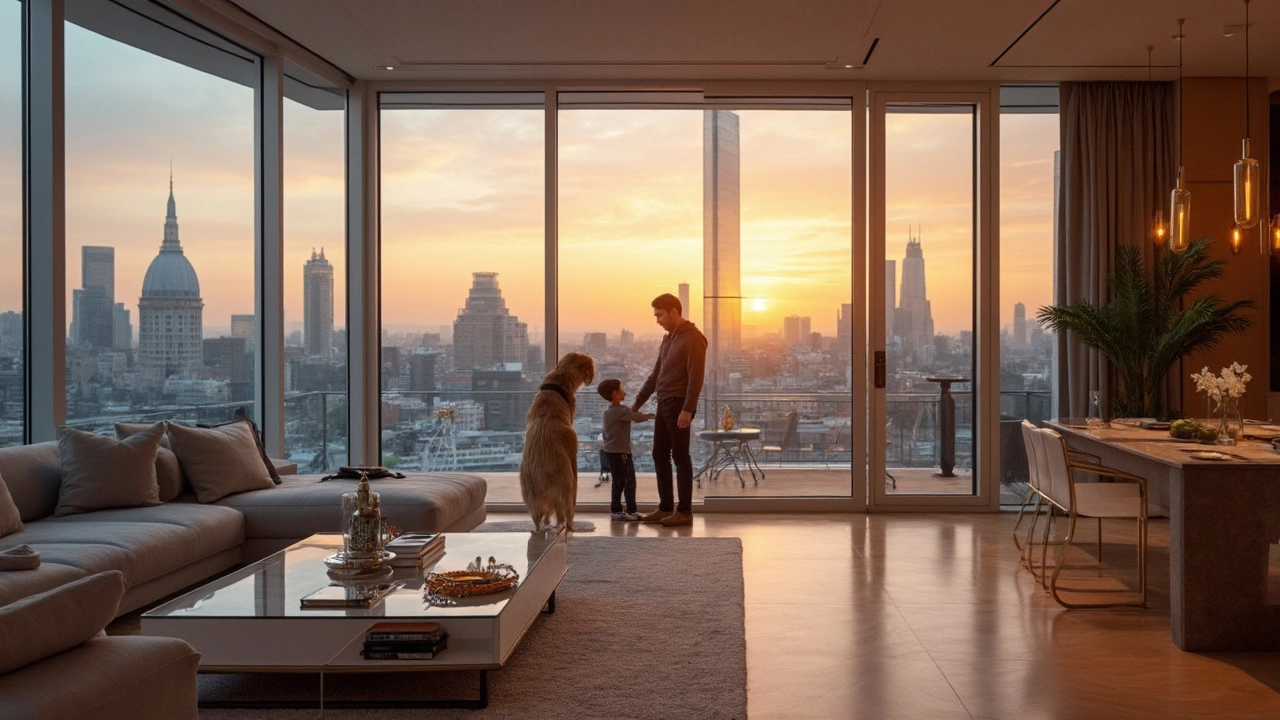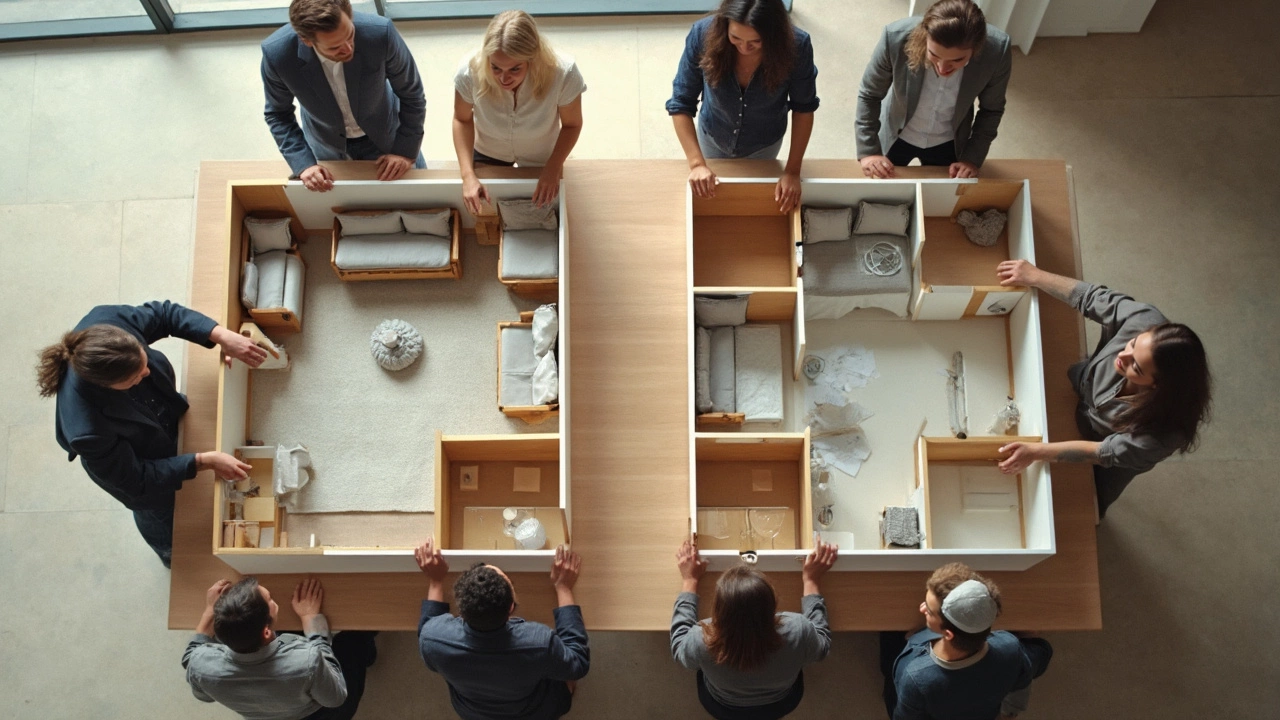Luxury Apartment Size: How Big is 'Big'?
 Apr, 29 2025
Apr, 29 2025
Ever walked into a high-end apartment and thought, "Wow, this feels huge!" but then looked at the floor plan and been surprised by the number? When people talk about luxury apartments, size is always part of the conversation—but what does “big” even mean in this world?
In places like New York, a 'luxury' apartment could start around 1,200 square feet for a one-bedroom, but in Dallas or Dubai, you might find two-bedroom units pushing 2,000 square feet or more. And let’s be real: the numbers don’t always tell the whole story. Open layouts and floor-to-ceiling windows can make a place feel twice as big, even if the official square footage isn’t jaw-dropping.
If you’re hunting for a luxury place, don’t just check the listing for the biggest number. Think about how you’ll actually live in the space. Walk-in closets, storage, and smart use of rooms often matter more than an extra 200 square feet tacked onto a hallway you’ll never use.
- What Counts as 'Luxury' in Apartment Size?
- Average Sizes Around the Globe
- How Layout and Ceilings Matter
- Amenities: Beyond Just Square Footage
- Tips for Choosing the Right Size for You
What Counts as 'Luxury' in Apartment Size?
So, what actually makes an apartment hit the 'luxury' mark in terms of size? It’s not the same everywhere. In Manhattan, a luxury apartment size kicks off around 1,200 square feet for a one-bedroom. In contrast, Miami and Los Angeles set the bar higher—think 1,500 to 1,800 square feet for a similar setup. Penthouse units and three- or four-bedrooms can easily push well over 3,000 square feet in cities with more space to build.
But it’s not all about a big number on paper. Luxury in size comes down to how livable that space actually feels. Here’s what usually sets a true luxury apartment apart from an average one:
- Open floor plans: Minimal walls, big shared spaces, and plenty of natural light make areas feel more expansive.
- Ceiling height: Nine feet is common for standard apartments, but in luxury, you’re usually seeing 10-foot ceilings or higher. Some even offer dramatic double-height rooms.
- Multiple bathrooms: Forget the old "one bath" deal. Two-bedroom luxury units almost always have two full baths, often with those spa-level showers or soaking tubs.
- Walk-in closets and storage: Expect roomy closets, big laundry areas, and maybe even extra storage outside your unit. In places like Chicago’s high-end towers, some units have entire storage rooms included.
It helps to compare averages across U.S. cities:
| City | Luxury 1-Bedroom (sq ft) | Luxury 2-Bedroom (sq ft) |
|---|---|---|
| New York | 1,200 | 1,500 |
| Los Angeles | 1,400 | 1,800 |
| Miami | 1,350 | 1,750 |
| Dallas | 1,500 | 2,000 |
Bottom line: a luxury apartment is as much about function and feel as it is about size. Don’t get caught up only in square footage—see how a space is designed and what it actually gives you. That’s where the real luxury lives.
Average Sizes Around the Globe
Let’s get real: luxury apartment size isn’t a one-size-fits-all thing. Where you live makes a huge difference. In the US, especially in cities like New York or San Francisco, high-end apartments usually range from 1,200 to 2,000 square feet for one or two bedrooms. In Miami or Los Angeles, you’ll sometimes see luxury pads hitting 2,500 square feet or more with some serious wow-factor views.
Outside the US, luxury can look a bit different. In London, a so-called "spacious" flat in Mayfair might be just 900 to 1,400 square feet, while in places like Dubai or Singapore, it’s not uncommon for a luxury two-bedroom to clock in at 1,800 square feet or larger. “Luxury buyers are now looking for more than just location—they want more personal space, sometimes double what’s typical in their city,” says Livable Real Estate CEO Thomas Grey.
"Space has always been a premium in cities like Hong Kong, but savvy developers are finding ways to make 1,000 square feet feel absolutely grand." — Rachel Ng, Asian Property Weekly
Here’s a quick snapshot for context:
| City | Average Luxury 2-Bedroom (sq ft) |
|---|---|
| New York | 1,400 - 1,900 |
| London | 1,000 - 1,500 |
| Dubai | 1,700 - 2,800 |
| Hong Kong | 800 - 1,200 |
| Sydney | 1,200 - 1,800 |
So, why all the variation? Some cities just have less space to offer—think Hong Kong or Tokyo—while others, like Dallas or Dubai, build bigger by default. Plus, what’s considered ‘luxury’ in one place might just be ‘average’ somewhere else. Bottom line: Always check what you’re getting for your money in square footage and don’t skip the fine print.

How Layout and Ceilings Matter
You can find two luxury apartments with the same square footage, but one just feels massive while the other seems cramped. That’s not some magic trick—it’s the layout and ceiling height at work. Most upscale places today ditch long, useless hallways for open-concept designs where kitchens, living rooms, and sometimes even home offices all connect in one seamless space. It’s not just about showing off, either; it actually makes a home more comfortable and lets in natural light, which is why so many luxury floor plans focus on an open feel.
Ceiling height is the other game-changer. Standard apartments usually come with ceilings around 8 feet. In the new luxury real estate market, you’ll often find ceilings kicking up to 10 or 12 feet, sometimes more. Doesn’t sound like much until you stand under them—the extra vertical space makes every room feel bigger, brighter, and just more 'high-end.' Developers have figured this out, which is why those big airy windows and loft vibes are everywhere now, especially in cities where every extra inch makes a difference.
If you really want a spot that looks and feels premium, go beyond square footage in your checklist. Here are quick layout tips to actually get that spacious vibe:
- Look for corner units or layouts with windows on multiple sides—maximizes light.
- Prioritize apartments with open kitchens and living rooms, fewer chopped-up small rooms.
- Tall ceilings (10 feet or above) instantly add to a sense of space and luxury.
- Check if there are awkward spaces, like weirdly long corridors or random storage that eat into usable area.
Take a look at how much ceiling height can change the way your place feels—it’s not just in your head.
| Ceiling Height | Perceived Spaciousness |
|---|---|
| 8 ft (Standard) | Typical, can feel boxy |
| 10 ft | Noticeably open, lets in more light |
| 12 ft+ | Loft-like, ultra-luxe, dramatic feel |
So, don’t just ask about square feet. Ask about the floor plan, window layout, and that all-important ceiling height if you want to spot true luxury apartment size.
Amenities: Beyond Just Square Footage
When you walk into a luxury apartment, the size grabs your attention, but the real perks are often in the extras. Think about it—what's better, a massive living room with nothing in it, or a slightly smaller one loaded with smart features and top-notch extras?
Most people expect fancy finishes: marble countertops, hardwood floors, and designer lighting. But that's just scratching the surface. These days, real luxury apartment buildings compete with their amenities as much as their square footage. For example, it’s now standard to have a fitness center that looks more like a boutique gym, a rooftop pool, even coworking spaces and movie theaters—sometimes all under one roof. In big cities, you might even find on-site pet spas, golf simulators, or wine cellars, just for residents.
Amenities don’t just make life easier—they change how the space feels day to day. For example, having a 24/7 doorman, package lockers, valet parking, or even in-unit laundry saves time and stress. In some newer buildings, you might get keyless entry, smart thermostats, and lightning-fast internet as part of the deal.
If you like specifics, check out this quick facts table—these are amenities that showed up most in recent luxury real estate listings worldwide:
| Amenity | % of Listings (2024) |
|---|---|
| 24/7 Concierge/Doorman | 84% |
| High-end Fitness Center | 72% |
| Rooftop Pool or Lounge | 68% |
| Smart Home Tech | 56% |
| Private Parking | 51% |
Bottom line: don’t just focus on the number of square feet. The real value in high-end living comes from all the ways an apartment makes your life smoother, whether it’s grabbing a coffee in a resident lounge or skipping the trip to the gym entirely. When touring a place, ask to see every shared area, not just the apartment itself. Sometimes the real luxury is outside your front door.

Tips for Choosing the Right Size for You
If you’re looking at luxury apartment size, it’s not just a numbers game. What works for one person—or a growing family—can feel totally wrong for someone else. So how do you know what’s right for you?
- Think about your daily routine. Do you work from home and need a dedicated office, or is a small desk in the corner fine? If you love having friends over, that open living room space isn’t just a nice-to-have—it’s a must.
- Pay attention to storage. Luxury doesn’t mean tripping over boxes or hunting for your winter coat. Look for built-in closets, large kitchen pantries, and hidden storage spots.
- Check how usable the space is. Sometimes 300 extra square feet just means a long hallway or awkward nook. A smart layout with flexible rooms (think sliding doors, open kitchens) usually beats raw square footage.
- Ask about ceilings and windows. A place with 10-12 foot ceilings feels way more spacious than the same footprint with standard ones. Full-height windows also do wonders for making everything feel bigger and brighter.
- Count the bathrooms. This surprises a lot of buyers—a second or third bath can completely change how you use your space, especially if you have guests or family staying over often.
Across the U.S., the average luxury apartment in 2024 clocks in at 1,450 square feet, according to data from RentCafe. But about 40% of high-end renters say they actually want something closer to 1,800 square feet, mostly because of extra home office and guest room needs.
| City | Avg. Luxury 2BR (sq ft) | Avg. Number of Bathrooms |
|---|---|---|
| Los Angeles | 1,620 | 2.5 |
| Miami | 1,750 | 2 |
| Dubai | 2,100 | 3 |
Don’t get hung up on the biggest numbers. Sometimes a slightly smaller spot in a prime building—packed with top-tier luxury apartment amenities—will fit your actual life way better than just grabbing more space you might not use.